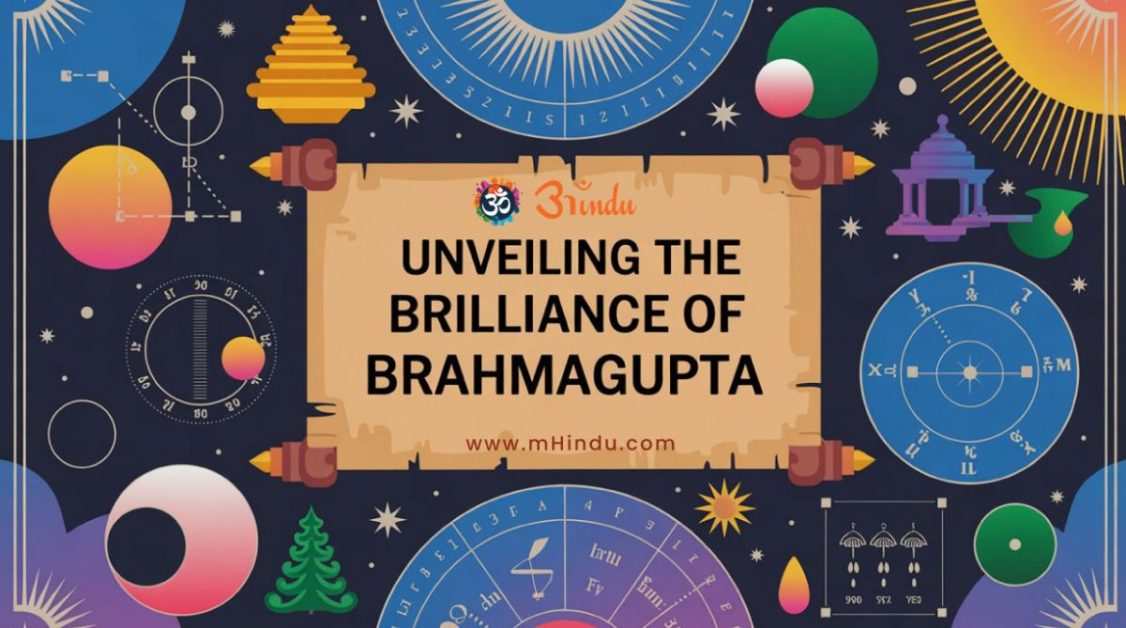
For millennia, the pursuit of knowledge has been deeply ingrained in the Hindu ethos. From the profound wisdom of the Vedas to the intricate calculations of ancient astronomers, a spirit of inquiry and a quest for understanding the universe have shaped our civilization. Within this rich tapestry of intellectual giants shines the luminous figure of Brahmagupta, a Hindu scholar whose groundbreaking contributions to mathematics and astronomy continue to resonate even today. This exploration delves into the life, discoveries, and enduring legacy of this remarkable individual, highlighting his profound impact on the world of numbers and the cosmos, a legacy that is a source of immense pride for the Hindu community.
Explore Blog Content
ToggleImagine a world without the concept of zero as a number, where negative quantities were mere abstractions, and solving equations was a cumbersome affair. This was the intellectual landscape before the advent of Brahmagupta (597 – 668 AD), a visionary born in Bhinmal, Rajasthan. Though he humbly considered himself an astronomer who dabbled in mathematics, history remembers him primarily for his revolutionary mathematical insights. His father, Jisnugupta, an astrologer, likely instilled in him an early fascination with celestial movements, which later blossomed into a deep understanding of both the heavens and the numerical language that governs them.
Brahmagupta‘s intellectual prowess flourished in Ujjain, the epicenter of ancient Indian mathematical astronomy. As the director of its astronomical observatory, he was at the heart of scholarly activity, a place where ideas converged and new frontiers of knowledge were explored. He penned four seminal works, including the influential ‘Brahmasphutasiddhanta’ (Brahma’s Correct System of Astronomy, or The Opening of the Universe), ‘Khandakhadyaka’, ‘Durkeamynarda’, and ‘Cadamakela’. Among these, the ‘Brahmasphutasiddhanta’, completed in 628 AD, stands as a monumental testament to his genius, comprising twenty-five chapters and over a thousand verses, a blend of astronomical observations and profound mathematical theorems.
Brahmagupta Contribution to Mathematics: Defining the Void and Beyond
Brahmagupta‘s most enduring contribution lies in his formalization of the number zero. While symbols for nothingness existed in earlier systems, it was Brahmagupta who dared to treat zero as a number in its own right, defining its properties and its interaction with other numbers. This was a conceptual leap of immense magnitude, one that eluded even the brilliant minds of ancient Greece. His understanding that subtracting a number from itself yields zero, and his initial (though partially incorrect) explorations of division by zero, laid the foundation for the arithmetic we use today.
His rules for operations involving zero, negative numbers (which he poetically termed “debt” or ṛṇa), and positive numbers (“wealth” or dhan) were groundbreaking. Consider these rules articulated in his own words:
- “A debt minus zero is a debt.” (−a−0=−a)
- “A fortune minus zero is a fortune.” (a−0=a)
- “Zero minus zero is a zero.” (0−0=0)
- “A debt subtracted from zero is a fortune.” (0−(−a)=a)
- “A fortune subtracted from zero is a debt.” (0−a=−a)
- “The product of zero multiplied by a debt or fortune is zero.” (0×−a=0, 0×a=0)
- “The product of zero multiplied by zero is zero.” (0×0=0)
- “The product or quotient of two fortunes is one fortune.” (a×b=ab, a/b=a/b)
- “The product or quotient of two debts is one fortune.” (−a×−b=ab, −a/−b=a/b)
- “The product or quotient of a debt and a fortune is a debt.” (−a×b=−ab, −a/b=−a/b)
- “The product or quotient of a fortune and a debt is a debt.” (a×−b=−ab, a/−b=−a/b)
These seemingly simple rules were revolutionary. They provided a consistent framework for dealing with negative numbers, which were often dismissed or considered absurd by his contemporaries. This opened up new avenues in algebra, allowing for the complete solution of equations that previously had no meaningful answers. For instance, the quadratic equation x2+2=11 could now be understood to have two solutions, x=3 and x=−3, because both 32=9 and (−3)2=9.
Brahmagupta further extended his algebraic insights by providing general solutions to linear and quadratic equations. He offered two equivalent solutions for the general quadratic equation of the form ax2+bx+c=0, a significant advancement in the field. His work on simultaneous equations with multiple variables also demonstrated a sophisticated understanding of algebraic structures.
Geometric Marvels: The Formula for Cyclic Quadrilaterals
Beyond algebra, Brahmagupta made remarkable contributions to geometry. His most celebrated achievement in this domain is the formula for the area of a cyclic quadrilateral – a four-sided figure whose vertices all lie on a single circle. Given the lengths of the sides p,q,r, and s, the area (A) is given by:
A=(S−p)(S−q)(S−r)(S−s)
where S is the semi-perimeter of the quadrilateral, calculated as:
S=2p+q+r+s
This elegant formula, now known as Brahmagupta‘s formula, is a generalization of Heron’s formula for the area of a triangle (which can be considered a cyclic quadrilateral with one side of length zero). This discovery showcases his deep understanding of geometric relationships and his ability to derive powerful and general results.
Contributions to Astronomy: Placing Earth in the Cosmos
Though he considered mathematics a source of pleasure, Brahmagupta‘s primary focus was astronomy. As the director of the Ujjain observatory, he was deeply involved in understanding celestial movements and developing accurate astronomical models. His ‘Brahmasphutasiddhanta’ is a comprehensive treatise covering various aspects of astronomy, including planetary longitudes, eclipses, the moon’s phases, and conjunctions of planets and stars.
While some of his astronomical conclusions have been superseded by later scientific advancements, his attempts to understand the cosmos were significant for his time. For instance, he correctly placed the Moon closer to Earth than the Sun. He also provided an estimate for the length of a year as 365 days, 6 hours, 12 minutes, and 9 seconds, remarkably close to the actual value. Furthermore, he calculated the Earth’s circumference to be approximately 36,000 km (22,500 miles), another impressive estimation for that era.
Interestingly, Brahmagupta initially posited that the Earth did not spin and did not orbit the sun, a view aligned with the prevailing religious beliefs of the time. Some historians speculate that this stance might have been a pragmatic decision to avoid conflict with the powerful Brahminical establishment. However, his later works hinted at different perspectives, showing a willingness to explore various cosmological ideas.
Brahmagupta also offered insightful observations about gravity, centuries before Newton’s formalization. He stated, “Bodies fall towards the earth as it is in the nature of the earth to attract bodies, just as it is in the nature of water to flow.” This intuitive understanding of a force pulling objects towards the Earth demonstrates his keen observational skills and his attempt to provide a naturalistic explanation for physical phenomena.
The Enduring Legacy of a Mathematical Luminary
Despite his self-perception as primarily an astronomer, Brahmagupta‘s mathematical contributions have had a far more profound and lasting impact on the world. His formalization of zero and negative numbers revolutionized arithmetic and algebra, paving the way for the development of calculus and modern mathematics. His formula for the area of cyclic quadrilaterals remains a testament to his geometric ingenuity.
It is important to acknowledge the recent discovery of the Bakhshali manuscript, dated between 200-400 AD, which contains the first documented use of zero as a placeholder in a numeral system. This predates Brahmagupta‘s work, indicating that the conceptualization of zero was evolving in India prior to his explicit definition of its properties as a number. However, Brahmagupta‘s ‘Brahmasphutasiddhanta’ is the earliest known text that provides rules for arithmetic operations involving zero and negative numbers, marking a crucial step in their integration into the mathematical framework.
The Hindu community takes immense pride in Brahmagupta‘s achievements. He embodies the spirit of intellectual curiosity and the pursuit of knowledge that has been a hallmark of our civilization for centuries. His work serves as a powerful reminder of the significant contributions of Hindu scholars to the global advancement of science and mathematics. His exploration of the abstract concept of zero, a symbol of nothingness that holds immense mathematical power, resonates with the Hindu philosophical understanding of the void and the infinite.
Brahmagupta‘s dedication to unraveling the mysteries of both numbers and the cosmos earned him the esteemed title ‘Ganita Chakra Chudamani’ – ‘The gem of the circle of mathematicians’ – bestowed upon him by his peers. His legacy continues to inspire mathematicians and scientists worldwide, a shining example of the intellectual brilliance that flourished in ancient India. His work is not just a historical footnote; it is a foundational pillar upon which much of modern mathematics rests. As members of the Hindu community, we cherish his contributions and recognize his profound impact on shaping our understanding of the universe and the elegant language of numbers that describes it.
FAQs on Brahmagupta: Unveiling More About the Great Mathematician
- What is Brahmagupta most famous for in mathematics?
Brahmagupta is most famously recognized for being the first to define the properties of zero as a number and for establishing rules for arithmetic operations involving zero and negative numbers. His formula for calculating the area of a cyclic quadrilateral is another significant mathematical contribution. - Did Brahmagupta invent zero?
While the concept of zero as a placeholder existed before Brahmagupta, as evidenced by the Bakhshali manuscript, Brahmagupta was the first mathematician to explicitly define zero as a number with its own properties and to describe how it interacts with other numbers in arithmetic operations. - What are some of the rules for zero and negative numbers given by Brahmagupta? Brahmagupta formulated rules such as: a debt minus zero is a debt, a fortune minus zero is a fortune, zero minus zero is zero, the product of zero with any number is zero, the product of two negative numbers is positive, and the product of a positive and a negative number is negative.
- What is Brahmagupta’s formula, and what does it calculate?
Brahmagupta’s formula is used to calculate the area of a cyclic quadrilateral (a four-sided figure whose vertices lie on a circle) given the lengths of its sides. The formula is A=(S−p)(S−q)(S−r)(S−s), where p,q,r,s are the side lengths and S is the semi-perimeter. - Besides mathematics, what other field did Brahmagupta contribute to?
Brahmagupta was also a significant contributor to astronomy. He directed the astronomical observatory in Ujjain and wrote extensively on topics such as planetary movements, eclipses, and the length of the year in his treatise ‘Brahmasphutasiddhanta’. - What was Brahmagupta’s view on the value of pi (π)?
Brahmagupta stated that the value of pi (π) could generally be taken as 3 for practical purposes. However, for more accurate calculations, he suggested using 10 (approximately 3.162), which is about 0.66 percent higher than the true value. - Did Brahmagupta have any incorrect theories?
Yes, while he made significant advancements, some of Brahmagupta’s astronomical theories were incorrect based on modern understanding. For example, he initially stated that the Earth did not spin or orbit the sun. He also made an error in defining division by zero. - How is Brahmagupta remembered today?
Today, Brahmagupta is revered as one of the most important mathematicians and astronomers of ancient India. His work on zero, negative numbers, solving equations, and cyclic quadrilaterals laid crucial foundations for the development of modern mathematics and continues to be studied and appreciated for its profound insights.
Please share this valuable information 👍







